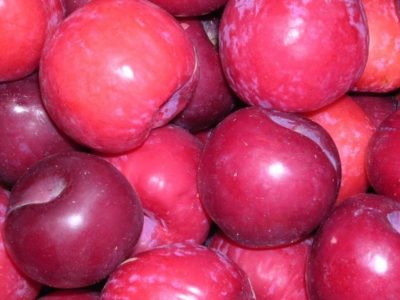
Plum
Plums are temperate fruits which when mature are often covered by a wax coating called "wax bloom". This gives them a bluish-grey appearance. They are usually eaten fresh. There are many varieties and a number of subspecies that all are known as plums or prunes.
Names
Scientific
Prunus domestica
English
Common plum
European plum
Gage
Plum
Prune
Dutch
Europese cultuurpruim
Kwets
Pruim
Pruimenboom
Spanish
Ciruelo
French
Prune
Prunier
German
Kultur-Pflaume
Pflaume
Italian
Prugna
Susina
Susino
Taxonomy
Order
Rosales
Family
Rosaceae
Genus
Prunus
Species
Prunus domestica (Plum)
Basic information and facts
Origin:
The plum probably originates from the Caucasus Mountains near the Caspian Sea.
Distribution:
These fruits are grown in most temperate regions. Highest production is in China, Serbia, USA, Turkey, Spain, Italy, France, and Romania.
Evergreen or deciduous:
The trees are deciduous.
Flowers:
Plum flowers in early spring. The flowers have 5 petals and are white.
Leaves:
Fruits:
The fruits are juicy with a sweet but sometimes tart taste (especially the skin). They are round, with a diameter of around 8 cm or smaller. The color varies according to the variety and can be red, yellow, blue or purple. Mature fruits sometime have a dusty-white coating that gives them a glaucous appearance. This natural wax is easily rubbed off.
Climate and weather:
Plums grow well in temperate climates.
Pollination:
Plums are pollinated by bees. Some types are self-fertile (they can be pollinated with their own pollen) but some varieties require pollen from another variety to be able to produce fruits.
Height:
Plum is usually large shrub or a small tree.
Spacing:
Propagation:
Plum trees grown from seed may not grow true to seed. Therefore plum trees are usually propagated through cuttings or grafting.
Insect pests:
Black aphids.
Diseases:
Plums are especially vulnerable to Silver leaf (Chondrostereum purpureum), which is a fungal disease that causes silvering of the leaves.
Fruit development:
Harvesting:
Plums must be harvested when they are ripe by hand picking, or shaking the tree and picking them up. If plums are not harvested immediately when they are ripe, the fruits may brown rot (a fungal disease).
Uses:
Plums are usually eaten fresh. Sometimes they are used to make plum wine. Some
plums are sold dried.
Proverbs and Quotes
- A black plum is as sweet as a white.
- A cherry year, a merry year; a plum year, a dumb year.
- If heaven above lets fall a plum, open your mouth.
- Receive a plum, return a peach.
- The higher the tree, the sweeter the plum
- There's no making apples of plums.
- You need plant only one cherry and one plum tree.
- What is more mortifying than to feel that you have missed the
plum for want of courage to shake the tree? (Logan Pearsall Smith) - Harvard takes perfectly good plums as students, and turns them
into prunes. (Frank Lloyd Wright) - The end of a novel, like the end of a children's dinner-party,
must be made up of sweetmeats and sugar-plums. (Anthony Trollope) - Like a prune, you are not getting any better looking, but you
are getting sweeter. (N. D. Stice)
Did you know that?
- Blue plums are red when they are green.
- Plums have a laxative effect.
Crop categories
Alcoholic drinks
Cool temperate crops
Fruits
Major crops
Mediterranean crops
Subtropical crops
Temperate crops
Pictures

Plum

Red plums
